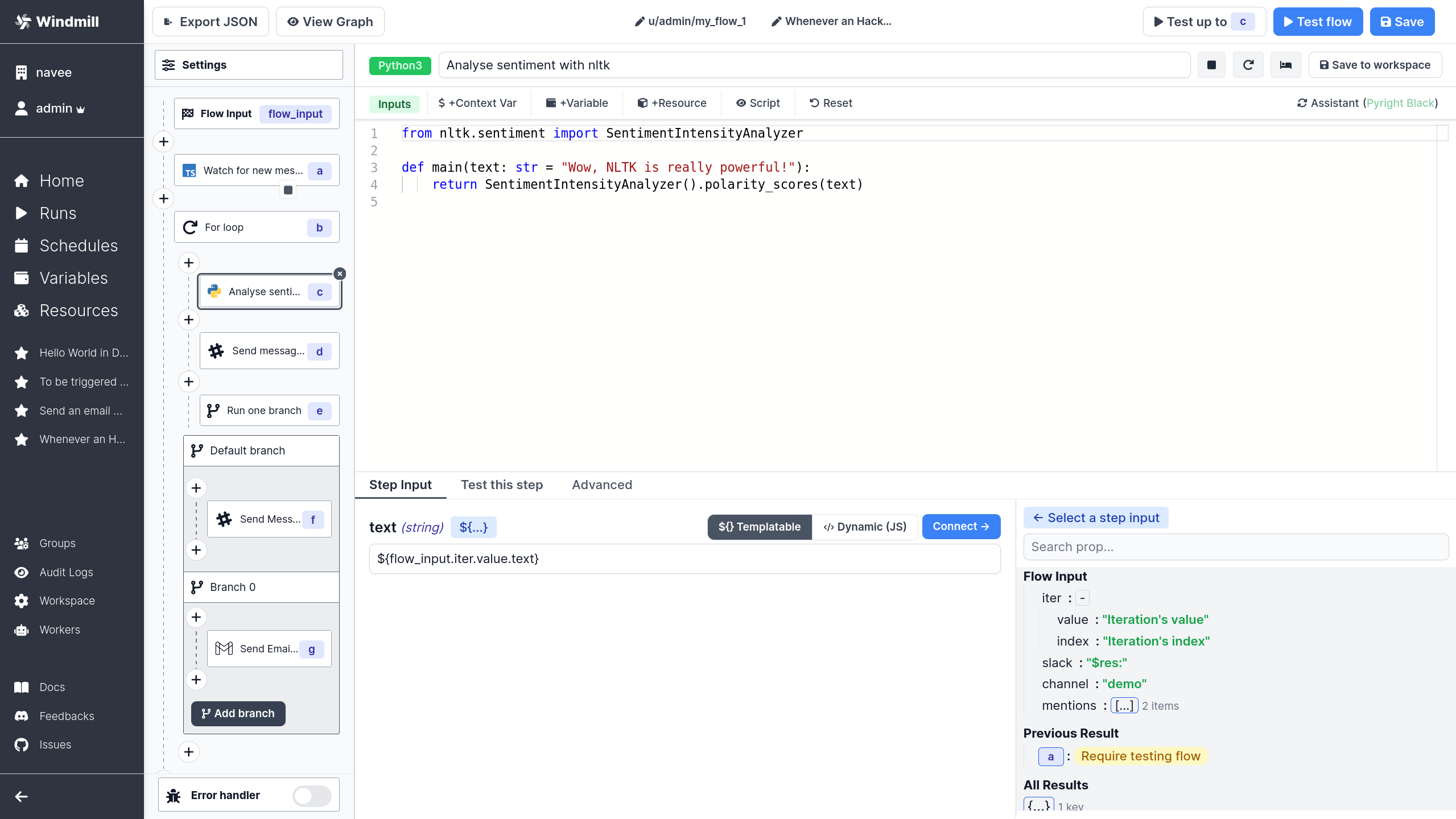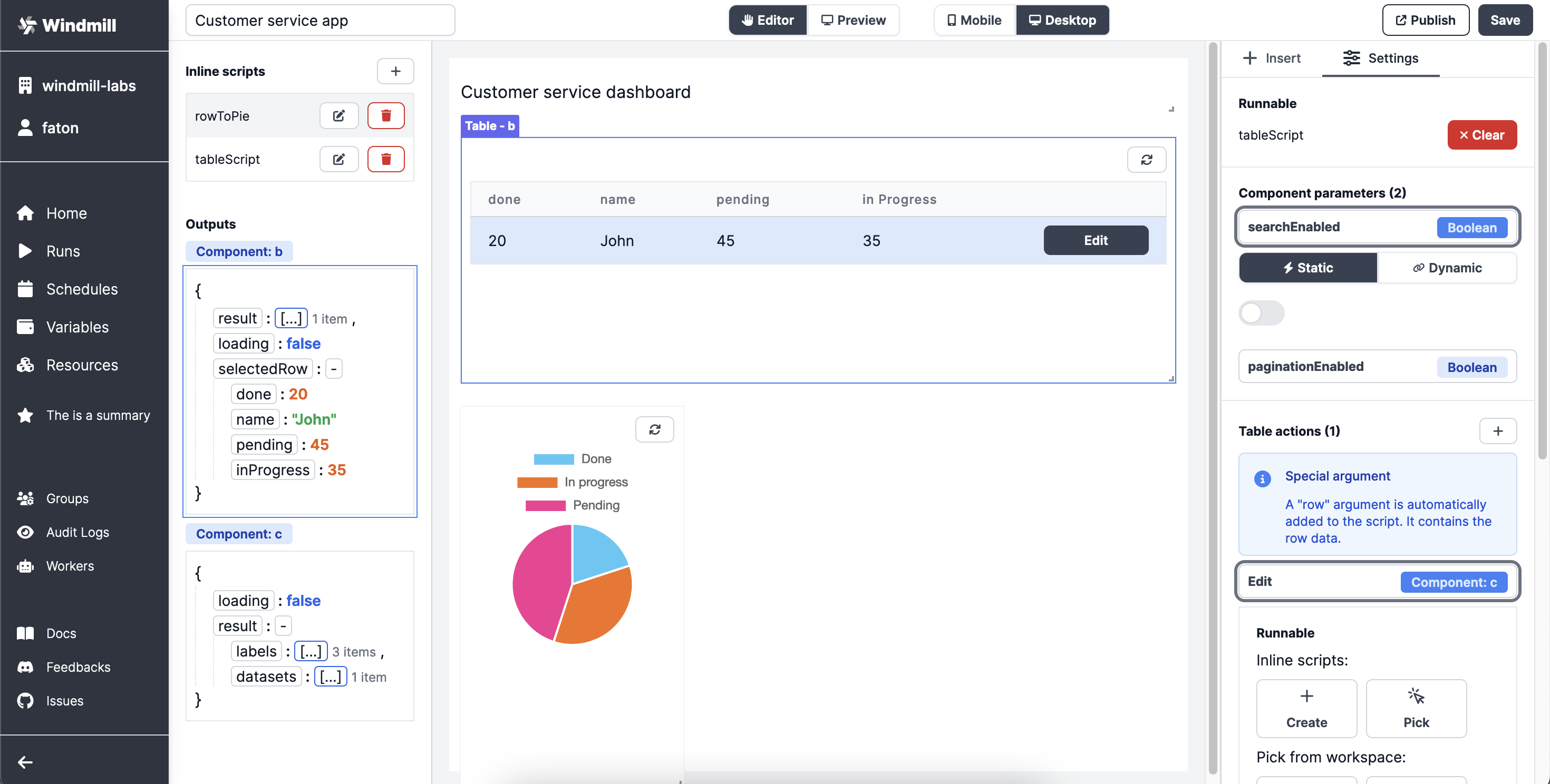.
Open-source developer infrastructure for internal tools. Self-hostable alternative to Airplane, Pipedream, Superblocks and a simplified Temporal with autogenerated UIs to trigger workflows and scripts as internal apps. Scripts are turned into UIs and no-code modules, no-code modules can be composed into very rich flows, and script and flows can be triggered from internal UIs made with a low-code builder. The script languages supported are: Python, Typescript, Go, Bash.
Try it (personal workspaces are free forever): https://app.windmill.dev
Documentation: https://docs.windmill.dev
Discord: https://discord.gg/V7PM2YHsPB
Contributor's guide: https://docs.windmill.dev/docs/contributors_guide
Roadmap: https://github.com/orgs/windmill-labs/projects/2
You can show your support for the project by starring this repo.
Windmill Labs offers commercial licenses, an enterprise edition, local hub mirrors, and support: contact ruben@windmill.dev.
Disclaimer: Windmill is in BETA. It is secure to run in production but we are still improving the product fast.
Windmill is fully open-sourced (AGPLv3):
- Windmill
-
Define a minimal and generic script in Python, Typescript, Go or Bash that solves a specific task. Here sending an email with SMTP. The code can be defined in the provided Web IDE or synchronized with your own github repo:
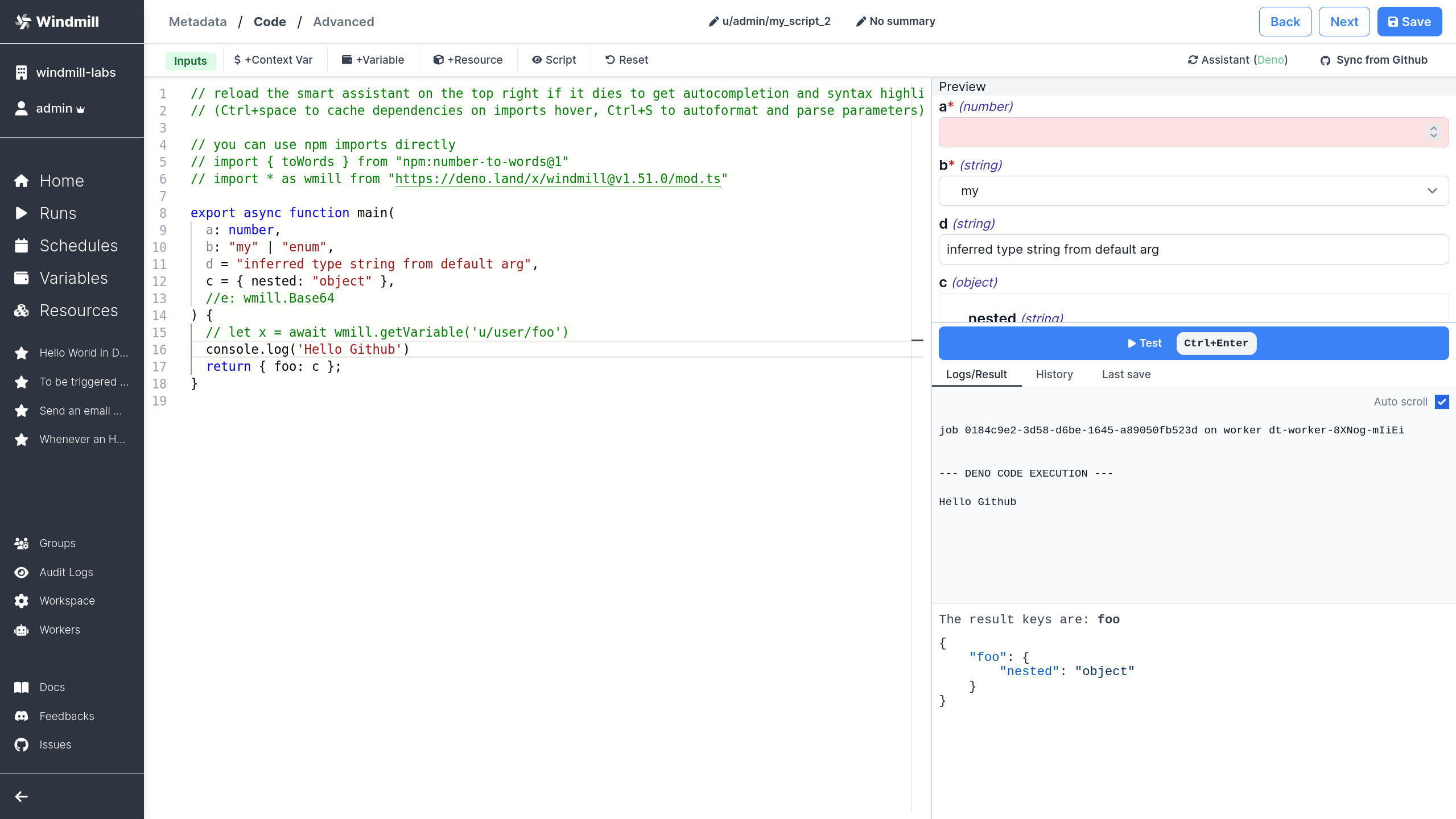
-
Your scripts parameters are automatically parsed and generate a frontend.
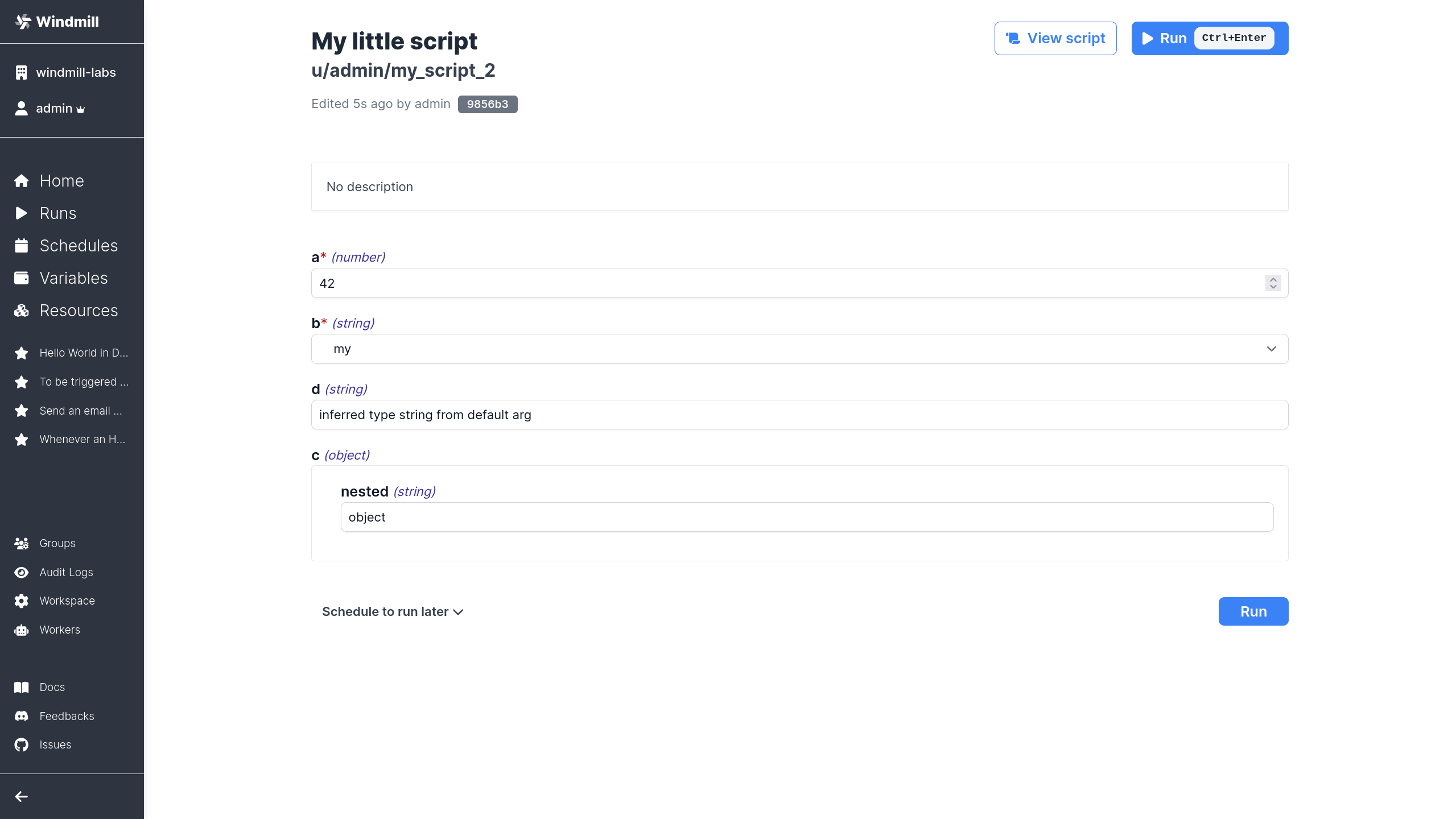
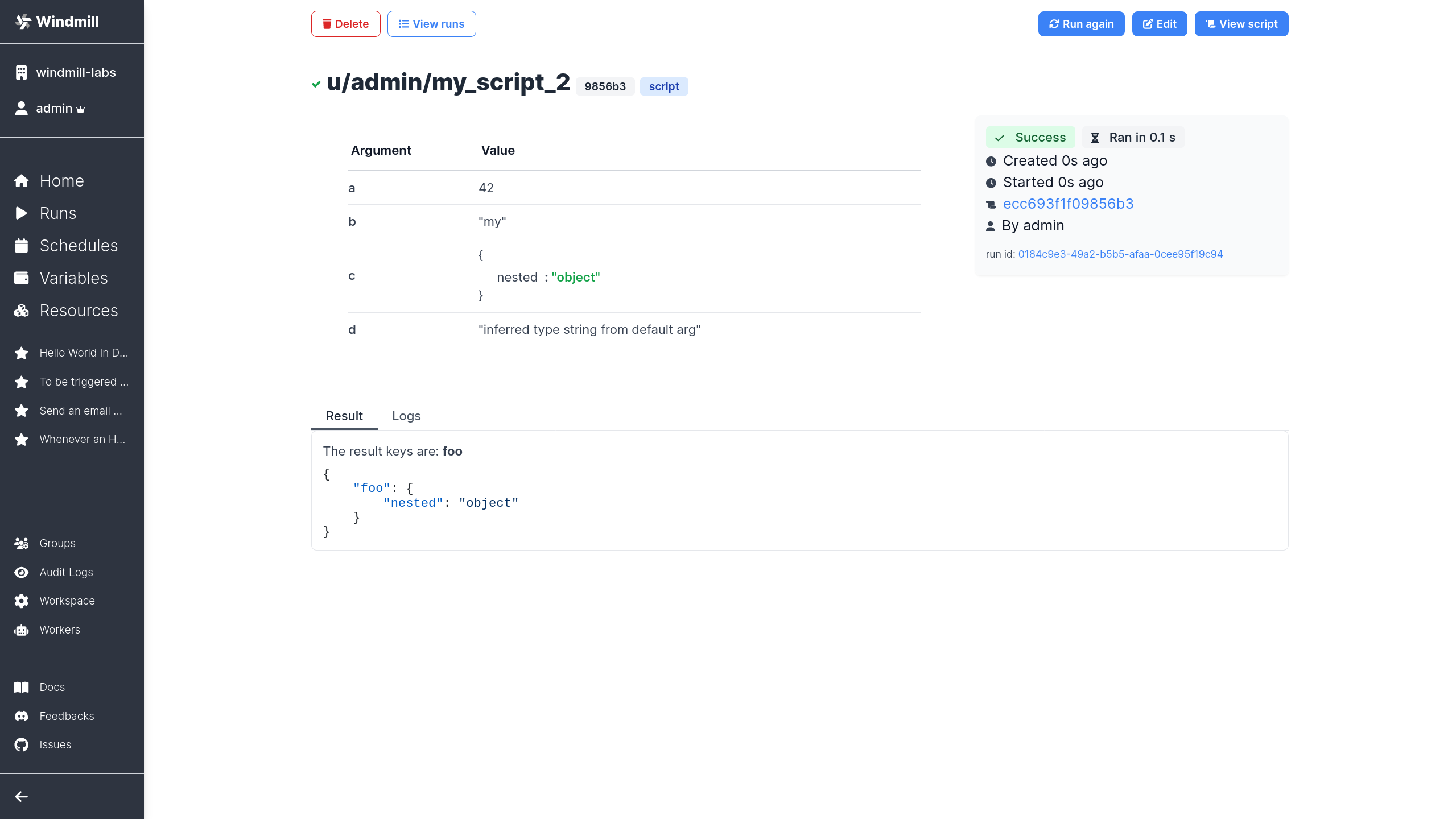
-
Make it flow! You can chain your scripts or scripts made by the community shared on WindmillHub.
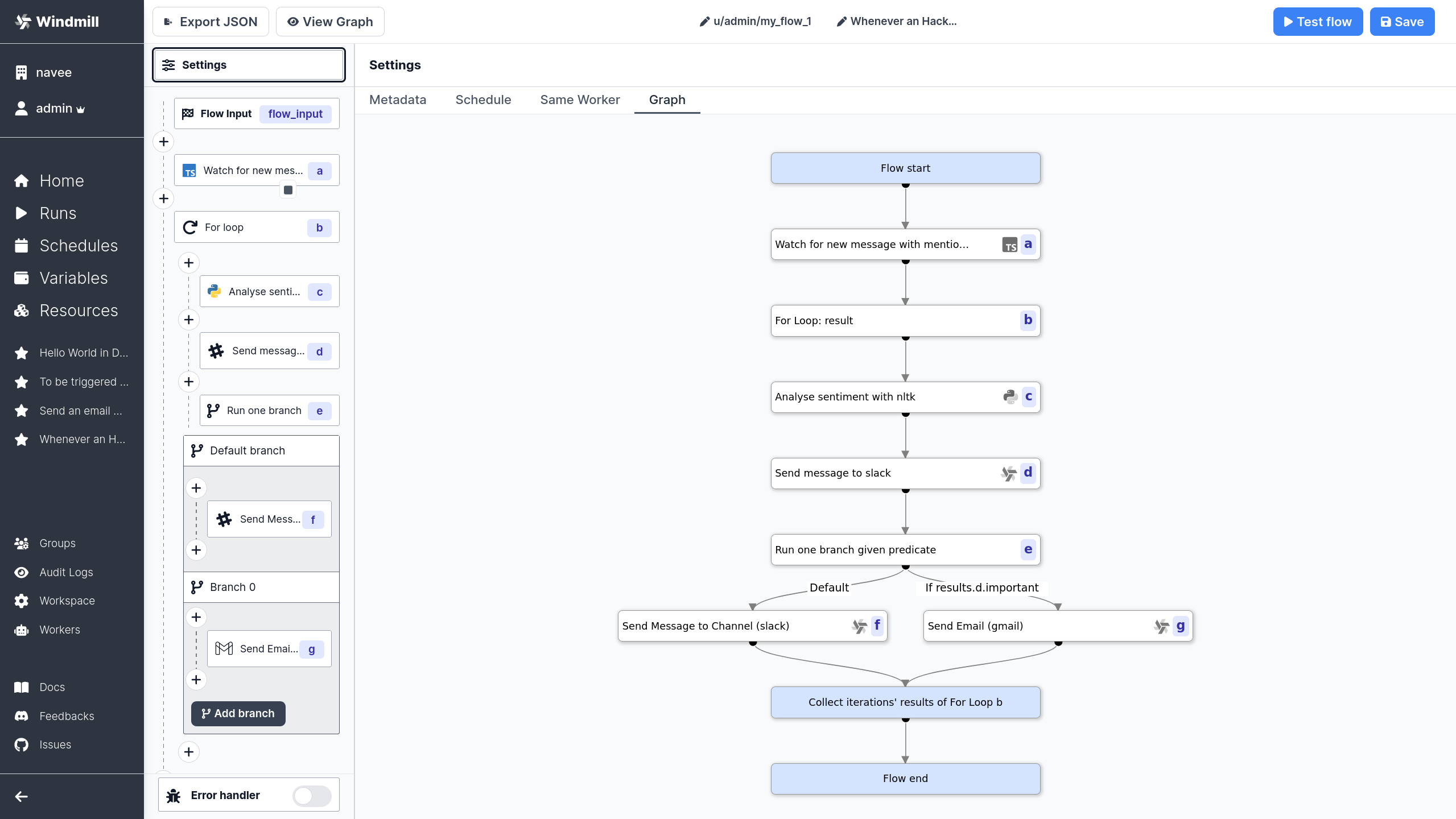
Scripts and flows can also be triggered by a cron schedule '*/5 * * * *' or through webhooks.
You can build your entire infra on top of Windmill!
We have a powerful CLI to interact with the windmill platform and sync your scripts from your own github repo. See more details
backend/: Rust backendfrontend: Svelte frontendlsp/: Lsp asssistant for the monaco editor<lang>-client/: Windmill client for the given<lang>
- Postgres as the database
- backend in Rust with the following highly-available and horizontally scalable
architecture:
- stateless API backend
- workers that pull jobs from a queue in Postgres (and later, Kafka or Redis. Upvote #173 if interested )
- frontend in Svelte
- scripts executions are sandboxed using google's nsjail
- javascript runtime is the deno_core rust library (which itself uses the rusty_v8 and hence V8 underneath)
- typescript runtime is deno
- python runtime is python3
- golang runtime is 1.19.1
Windmill uses nsjail on top of the deno sandboxing. It is production multi-tenant grade secure. Do not take our word for it, take fly.io's one
There is one encryption key per workspace to encrypt the credentials and secrets stored in Windmill's K/V store.
In addition, we strongly recommend that you encrypt the whole Postgres database. That is what we do at https://app.windmill.dev.
Once a job started, there is no overhead compared to running the same script on the node with its corresponding runner (Deno/Go/Python/Bash). The added latency from a job being pulled from the queue, started, and then having its result sent back to the database is ~50ms. A typical lightweight deno job will take around 100ms total.
We only provide docker-compose setup here. For more advanced setups, like compiling from source or using without a postgres super user, see documentation
docker compose up with the following docker-compose is sufficient:
https://github.com/windmill-labs/windmill/blob/main/docker-compose.yml
Go to https://localhost et voilà :)
For older kernels < 4.18, set DISABLE_NUSER=true as env variable, otherwise
nsjail will not be able to launch the isolated scripts.
To disable nsjail altogether, set DISABLE_NSJAIL=true.
The default super-admin user is: admin@windmill.dev / changeme
From there, you can create other users (do not forget to change the password!)
We publish helm charts at: https://github.com/windmill-labs/windmill-helm-charts
To self-host Windmill, you must respect the terms of the AGPLv3 license which you do not need to worry about for personal uses. For business uses, you should be fine if you do not re-expose it in any way Windmill to your users and are comfortable with AGPLv3.
To re-expose any Windmill parts to your users as a feature of your product, or to build a feature on top of Windmill, to comply with AGPLv3 your product must be AGPLv3 or you must get a commercial license. Contact us at license@windmill.dev if you have any doubts.
In addition, a commercial license grants you a dedicated engineer to transition your current infrastructure to Windmill, support with tight SLA, audit logs export features, SSO, unlimited users creation, advanced permission managing features such as groups and the ability to create more than one workspace.
To get the same oauth integrations as Windmill Cloud, mount oauth.json with
the following format:
{
"<client>": {
"id": "<CLIENT_ID>",
"secret": "<CLIENT_SECRET>",
"allowed_domains": ["windmill.dev"] //restrict a client OAuth login to some domains
}
}and mount it at /usr/src/app/oauth.json.
The redirect url for the oauth clients is: <instance_url>/user/login_callback/<client>
The list of all possible "connect an app" oauth clients
To add more "connect an app" OAuth clients to the Windmill project, read the Contributor's guide. We welcome contributions!
You may also add your own custom OAuth2 IdP and OAuth2 Resource provider:
{
"<client>": {
"id": "<CLIENT_ID>",
"secret": "<CLIENT_SECRET>",
// To add a new OAuth2 IdP
"login_config": {
"auth_url": "<auth_endpoint>",
"token_url": "<token_endpoint>",
"userinfo_url": "<userinfo endpoint>",
"scopes": ["scope1", "scope2"],
"extra_params": "<if_needed>"
},
// To add a new OAuth2 Resource
"connect_config": {
"auth_url": "<auth_endpoint>",
"token_url": "<token_endpoint>",
"scopes": ["scope1", "scope2"],
"extra_params": "<if_needed>"
}
}
}You will also want to import all the approved resource types from WindmillHub. There is no automatic way to do this automatically currently, but it will be possible using a command with the upcoming CLI tool.
| Environment Variable name | Default | Description | Api Server/Worker/All |
|---|---|---|---|
| DATABASE_URL | The Postgres database url. | All | |
| DISABLE_NSJAIL | true | Disable Nsjail Sandboxing | |
| NUM_WORKERS | 3 | The number of worker per Worker instance (set to 1 on Eks to have 1 pod = 1 worker) | Worker |
| METRICS_ADDR | None | The socket addr at which to expose Prometheus metrics at the /metrics path. Set to "true" to expose it on port 8001 | All |
| JSON_FMT | false | Output the logs in json format instead of logfmt | All |
| BASE_URL | http://localhost:8000 | The base url that is exposed publicly to access your instance | Server |
| BASE_INTERNAL_URL | http://localhost:8000 | The base url that is reachable by your workers to talk to the Servers. This help avoiding going through the external load balancer for VPC-internal requests. | Worker |
| TIMEOUT | 300 | The timeout in seconds for the execution of a script | Worker |
| SLEEP_QUEUE | 50 | The number of ms to sleep in between the last check for new jobs in the DB. It is multiplied by NUM_WORKERS such that in average, for one worker instance, there is one pull every SLEEP_QUEUE ms. | Worker |
| MAX_LOG_SIZE | 500000 | The maximum number of characters a job can emit (log + result) | Worker |
| DISABLE_NUSER | false | If Nsjail is enabled, disable the nsjail's clone_newuser setting |
Worker |
| KEEP_JOB_DIR | false | Keep the job directory after the job is done. Useful for debugging. | Worker |
| LICENSE_KEY (EE only) | None | License key checked at startup for the Enterprise Edition of Windmill | Worker |
| S3_CACHE_BUCKET (EE only) | None | The S3 bucket to sync the cache of the workers to | Worker |
| TAR_CACHE_RATE (EE only) | 100 | The rate at which to tar the cache of the workers. 100 means every 100th job in average (uniformly randomly distributed). | Worker |
| SLACK_SIGNING_SECRET | None | The signing secret of your Slack app. See Slack documentation | Server |
| COOKIE_DOMAIN | None | The domain of the cookie. If not set, the cookie will be set by the browser based on the full origin | Server |
| SERVE_CSP | None | The CSP directives to use when serving the frontend static assets | Server |
| DENO_PATH | /usr/bin/deno | The path to the deno binary. | Worker |
| PYTHON_PATH | /usr/local/bin/python3 | The path to the python binary. | Worker |
| GO_PATH | /usr/bin/go | The path to the go binary. | Worker |
| PIP_INDEX_URL | None | The index url to pass for pip. | Worker |
| PIP_EXTRA_INDEX_URL | None | The extra index url to pass to pip. | Worker |
| PIP_TRUSTED_HOST | None | The trusted host to pass to pip. | Worker |
| PATH | None | The path environment variable, usually inherited | Worker |
| HOME | None | The home directory to use for Go and Bash , usually inherited | Worker |
| DATABASE_CONNECTIONS | 50 (Server)/3 (Worker) | The max number of connections in the database connection pool | All |
| SUPERADMIN_SECRET | None | A token that would let the caller act as a virtual superadmin superadmin@windmill.dev | Server |
This will use the backend of https://app.windmill.dev but your own frontend with hot-code reloading.
- Install caddy
- Go to
frontend/:npm install,npm run generate-backend-clientthennpm run dev- In another shell
sudo caddy run --config CaddyfileRemote
- Et voilà, windmill should be available at
http://localhost/
See the ./frontend/README_DEV.md file for all running options.
- Create a Postgres Database for Windmill and create an admin role inside your
Postgres setup. The easiest way to get a working postgres is running
cargo install sqlx-cli && sqlx migrate run. This will also avoid compile time issue with sqlx'squery!macro - Install nsjail and have it accessible in your PATH
- Install deno and python3, have the bins at
/usr/bin/denoand/usr/local/bin/python3 - Install caddy
- Install the lld linker
- Go to
frontend/:npm install,npm run generate-backend-clientthennpm run dev- In another shell
npm run buildotherwise the backend will not find thefrontend/buildfolder and will crash - In another shell
sudo caddy run --config Caddyfile
- Go to
backend/:DATABASE_URL=<DATABASE_URL_TO_YOUR_WINDMILL_DB> RUST_LOG=info cargo run - Et voilà, windmill should be available at
http://localhost/
Windmill Labs, Inc 2022



